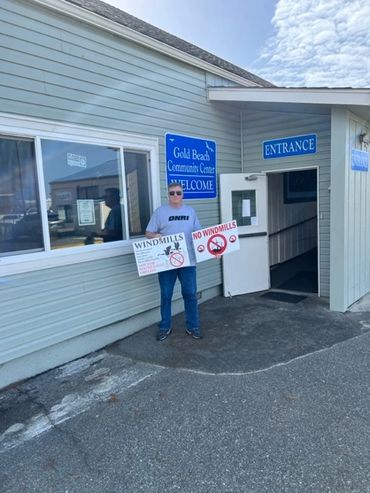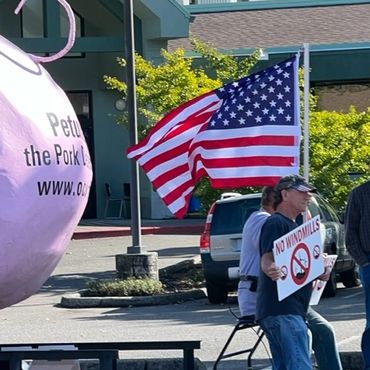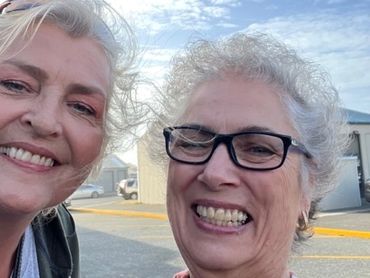Oregon Natural Resource Industries Stand Against the ODF 2023 HCP
KCBY Television
Wind Farms? Not on the Oregon Coast!
KCBY Television
Wind Farms? Not on the Oregon Coast!
World News

Gold Beach BOEM Meeting
Federal Bureau of Ocean Energy Management (BOEM) officials held the first of three in-person meetings with residents potentially affected by their decision to create floating offshore wind energy projects approximately 20 miles offshore extending from Coos Bay to Brookings.
About 115 people attended the first hour of the four-hour open house Sept. 26, where scientists and other officials from the BOEM and the National Centers for Coastal Ocean Sciences described the processes and impacts involved in the massive project that, according to the BOEM Visual Simulation Fact Sheet, would “place 262 turbines [over 219,568 acres of ocean.] Each turbine would have a hub height of 725 ft, rotor diameter of 935 ft, and maximum height at the blade tip of 1,171 ft. the Turbines are modeled in a grid pattern, 1 nautical mile apart.”
Those attending were greeted at the entrance by a small phalanx of a group in opposition to the project holding signs with “No Windmills” logos. Many of those signs were obvious throughout the inside of the Gold Beach Community Center where the meeting was held.
Inside the hall, there was opposition as well. Thena Lyons, a Brookings resident who came up for the meeting in Gold Beach, had addressed the City Council at its monthly meeting Sept. 25, and who quote, “took a day off, watched the virtual meeting from 9 to 3 to get a feel for it. There are a lot of questions they can’t answer” she said.
Lyons expressed her opposition in Gold Beach by walking through the community center with a “no windmills” sign she got from ONRI, the Oregon Natural Resource Industries, an advocacy group that describes itself as “the working men and women whose livelihoods are based on natural resource industries, including foresters, loggers, ranchers, truckers, miners, fishers, and farmers.”
Lyons stated that she was not allied with the ONRI.
ONRI Board Member, Diane Rich was one of those at the entrance to the Gold Beah meeting. She described her opposition to The Plot.
“Windmills are the most expensive electrical generating process known to man, and we don't want them on our coast,” she said. “We want to protect our fishermen. We want to protect our fish. We want to protect our whales. Windmills are not right for the Oregon Coast.”
Both Curry County and Brookings elected officials have expressed opposition to the wind energy plans as they currently proposed. There is opposition on other fronts as well.
Brad Kneaper, chair of the tribal council of the Confederated Tribes of the Coos, Lower Umpqua and Siuslaw Indians said he supports green energy development, but he said the current plans for projects along the Oregon Coast would risk the health of fisheries and the local fishing industry.
“We cannot support offshore wind development until we are provided assurance that it will do good and not harm the tribe, its members and the greater community,” he said in a statement.
The decision to host the in-person meetings about the projects, and to double the standard 30-day comment period required of such plans, follows pressure from Gov. Tina Kotek and U.S. Sens. Ron Wyden and Jeff Merkley of Oregon and Oregon’s congressional Reps. Suzanne Bonamici and Val Hoyle.
Wednesday, Sept. 27 a similar open house was scheduled in Coos Bay where a large demonstration in opposition was planned by ONRI. Another public session was scheduled for Brookings at Southwestern Oregon Community College Sept. 28. Public comments can be sent to the federal agency online through Oct. 16.
The Oregon Congressional members sent two letters to Elizabeth Klein, the ocean energy agency’s director, in June and August asking the bureau to pause the process of identifying and leasing offshore wind areas until there was more collaboration with stakeholders.
“Renewable energy is an essential piece of the strategy to combat the climate crisis. However, local communities and fishermen have to be at the center for decisions about offshore wind projects that affect their livelihoods,” Wyden said in a statement.
The federal agency and the Oregon Department of Land Conservation and Development have held more than 75 meetings with Oregonians about offshore wind development since 2021. These include meetings with coastal communities, the public, elected officials, county commissioners, Oregon seafood commodity commissions, tribal nations, representatives from the wind industry, research and environmental organizations, the Oregon Ocean Policy Advisory Council and the Pacific Fishery Management Council.
Oregon Capital Chronicle is part of States Newsroom, a network of news bureaus supported by grants and a coalition of donors as a 501c(3) public charity. Oregon Capital Chronicle maintains editorial independence. Contact Editor Lynne Terry for questions: info@oregoncapitalchronicle.com.
BOEM Meetings Protested, No Transparency or Public Interaction






Curry, Coos, and Douglas Counties Sign Proclamations against BOEM





Protest Signs Pop Up Everywhere!






Copyright © 2024 Oregon Stronger Together - All Rights Reserved.
Marketed by ACTNowRetentionServices